2 Dec 2021

A large proportion of the commonly encountered conditions of the pet chicken are preventable. A thorough understanding of predisposing factors and other causes of these diseases will enable the owner and vet to dramatically improve the welfare of these important pets.
Primary health care for chickens includes advice and support for clients on diet, husbandry and parasite control. Digestive anatomy, physical examination, the approach to common conditions, and their management in a food-producing animal will help to give clinicians more confidence in their approach to the healthy and sick pet chicken.
A pet chicken-friendly practice is aware and supportive of the different needs of this prey species. Chickens make wonderful pets for children and adults, and are very popular.
A large proportion of the commonly encountered conditions of pet chickens are preventable. A thorough understanding of predisposing factors and other causes of these diseases will enable the owner and vet to dramatically improve the welfare of these important pets.

Pet chickens’ lifespan can vary from 4 to 10 years, although a 17-year-old hen has been recorded. Primary health care for chickens includes advice and support for clients on diet, husbandry and parasite control. This article will also discuss the approach to some common conditions related to problems with these key areas.
As a large proportion of the commonly encountered conditions of the pet chicken are preventable, client education has an important role in improving the health and welfare of these animals. The new chicken owner may also be new to keeping pets.
We as veterinarians are well placed to provide this information to our clients during consultations – verbally, via printed/digital care sheets, and via the practice newsletter, social media and website.
Hosting regular chicken posts on social media or lectures for owners is also an excellent way to educate a large group of clients, and increases the vet and client relationship at a time when the chicken is well. Clients are then more likely to bring the chicken in earlier for a “check-up” when they suspect their chicken is unwell as they feel the practice can provide good support and advice when they need it. Several key areas of chicken health care exist that clients need to know from their first visit.
Chickens are omnivores with a typical avian digestive tract. They have no teeth, but a hard beak. The crop (out-pocketing of the oesophagus) is for food storage, and is usually full in the evening and should be empty in the morning. The food then travels first to the proventriculus (glandular stomach), then the ventriculus (or gizzard, the thick muscular stomach used to grind food), which then leads to the simple small and large intestines.
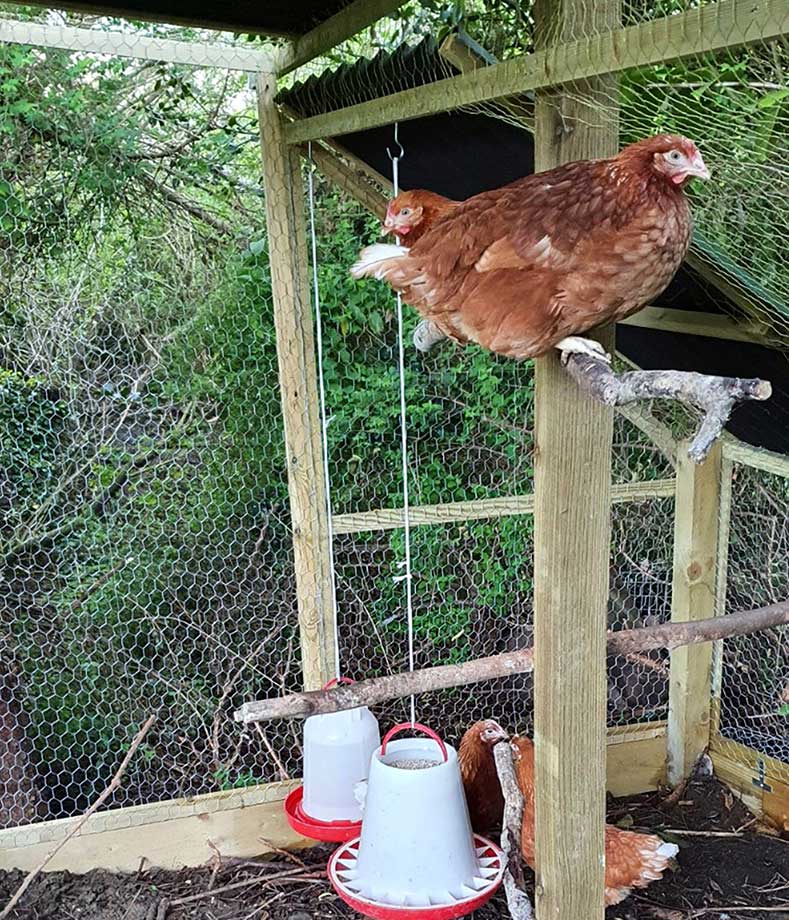
Chickens have paired ceca for fermentation of fibrous material from the diet and they empty their contents two to three times a day, producing pasty tan to dark brown-coloured sticky droppings that have a stronger odour than the main droppings.
The frequency and appearance of cecal droppings is a good reflection of digestive health. The cecal droppings are usually passed once daily, often in the morning. In the cloaca there is a mixing of faeces and white urates excreted from the urinary system. Normal faeces have a semi-sold brown faecal part, white urates and a puddle of clear urine (Figure 1).
Pet chickens are best fed a complete, balanced, commercial chicken pellet as other poultry have different nutrient requirements and diets (Figures 2 and 3). A laying hen needs around 120g to 150g of food a day and this should be increased a bit in the winter (The Chicken Vet, 2021).
Obesity is a problem for pet chickens, therefore the food should be measured and bodyweight monitored regularly. Commercial pellets should be stored away from damp and light to prevent mycotoxins, aspergillus spores or vitamin degradation in rodent-proof containers.
Malnutrition, stress, oral antibiotic and corticosteroid (very immunosuppressant in avian species) can lead to sour crop, where Candida albicans causes a yeast infection of the crop. Clinical signs include lethargy, regurgitation, delayed crop emptying and diarrhoea. Ketoconazole, nystatin, other antifungals and metoclopramide are not permitted for use in poultry in the UK as they are food animals.
Treatment of sour crop and crop impactions mainly involves supportive therapy, and manual emptying of the crop under general anaesthesia (isoflurane is permitted in a food animal) may also be indicated.
Electrolytes, nutritional support and probiotics may be administered by gavage using a crop tube or adapted soft feeding tube from a drip giving set to safely bypass the glottis situated at the base of the tongue. Give a maximum of 30ml/kg per feed (start with 10ml/kg and increase provided no regurgitation is seen).
Keep the bird warm and comfortable. Apple cider vinegar can be given orally by gavage or in the drinking water. The use of apple cider vinegar as an antifungal has been described anecdotally; however, some evidence of efficacy exists against candida species in human medicine. The minimal inhibitory concentration of apple cider vinegar was found to be 0.25% for Candida species collected from immunocompromised humans (Manohar and Gopinath, 2017).

Vitamin and mineral deficiencies can be a cause of poor egg quality, lameness and multiple health problems. The expiry date on the food should be checked as vitamins degrade over time. A handful of mixed corn can be scatter fed in the garden or run to encourage foraging and scratching. The occasional meal worm or small amount of bread can be fed as a treat. Kitchen scraps should be avoided.
A sudden diet change or change in brand of feed should be avoided as this is a common cause of diarrhoea. Natural grazing on grass or feeding a handful of leafy greens can be good for environmental enrichment. Ingestion of long grass can lead to a crop impaction.
Grit should be offered if the chickens are on grass or fed whole grains to aid grinding in the ventriculus, but otherwise grit is not essential. Water should always be available and ideally offered in a raised drinker to avoid faecal contamination. The maintenance rate is 50ml/kg/day for non-laying birds and 100ml/kg for laying birds.
Pet chickens are usually kept in sheds, wooden hutches, plastic coops with a run, or free range in the garden, when avian influenza restrictions allow. All the bedding should be removed weekly and composted or burnt if red mite infection is present.
Thorough cleaning (including beds and perches) with soap and water should be carried out before disinfection of the shed/hutch or coop. Wet bedding by the drinker should be removed and replaced daily to avoid bumble foot and reduce coccidian oocyst sporulation.
The grazing area should be managed with regular removal of faeces and where possible regularly stock movement or returfing to reduce worm build-up. Ulceration of the skin over the plantar surface of the feet, hock or sternum are not uncommon if the chickens are kept in dirty litter or spending more time sitting due to lameness or illness.
Feather pecking activity can range from gentle pecking, severe pecking, vent pecking, cannibalism and aggressive pecking.
Physical examination should be thorough and carried out as for other species. Species differences will be pointed out. The respiratory rate should be observed from a distance prior to handling if possible and a range of 12bpm to 37bpm is considered normal. Tail bobbing, wheezing or open mouth breathing are signs of severe respiratory disease, and should prompt moving the chicken into an oxygen cage prior to handling.
Many respiratory pathogens are seen in pet chickens, with Mycoplasma gallisepticum being common. However, backyard chickens are also highly susceptible to the notifiable diseases avian influenza and less often seen Newcastle disease.
Weighing the chicken and comparing previous records can be a valuable assessment of these prey species that hide signs of disease. Most pet hens are used to gentle handling.
Loosely wrapping a towel around to hold the wings to the body can make handling easier and allow the hen to be scooped under an arm of the handler to allow examination of the legs, feet, and vent for any lesions and normal mobility assessed. Support the abdomen from below and the legs can be held in one hand.
Poor restraint can lead to shock moult. Stressed birds should have their eyes covered with loose bandaging or a small sock placed over the head. Care must be taken with cockerels that have larger sharp tarsometatarsal spurs (Figure 4). No pressure should be applied to the thoracic or abdominal regions.
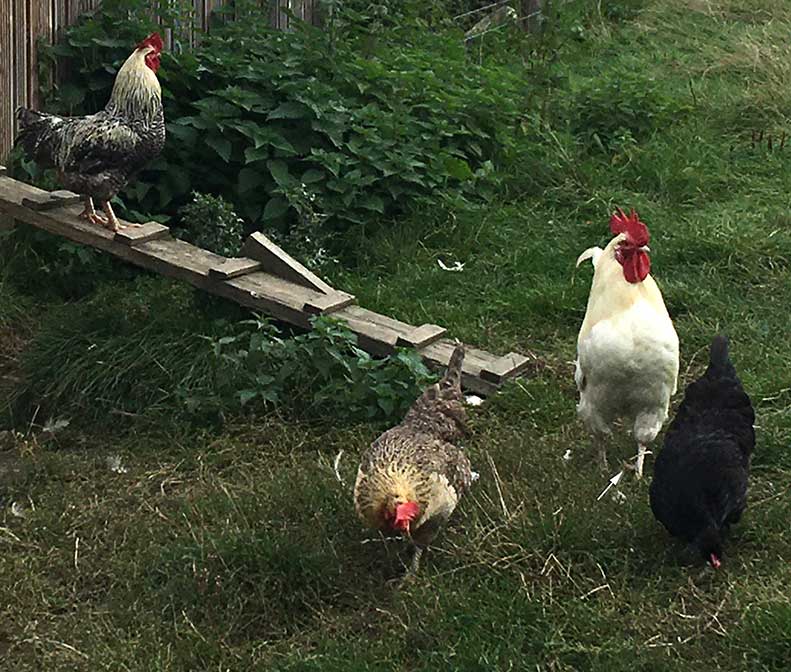
Auscultation of the nine airsacs over the thoracic and abdominal regions should be quiet; clicking sounds may be suggestive of airsaculitis. The nostrils should be clean and swelling over the sinus region is suggestive of sinusitis.
Open the beak with gentle digital traction to allow examination of the glottis at the base of the tongue and the choana (connects the nasal and oral cavity) a slit on the dorsal region of the mouth. Both should be clean and free of mucous, plaques or signs of inflammation. The wattle and comb colour should be noted, as this very vascular structure can be more purple in colour, suggesting cyanosis, with pale suggesting anaemia (Figure 5).

The neck and cranial thorax region should be palpated to assess the crop, which should be empty in the morning, or no fuller than about 5cm. The reference range for the normal heart rate is 220bpm to 360bpm. The keel region should be palate to assess the body condition of the bird (Panel 1).
Score 1 – emaciated
Score 2 – lean
Score 3 – ideal
Score 4 – too heavy
Score 5 – obese
The brood spot is a temporary featherless region on the ventral thorax seen in birds brooding on eggs. Gentle palpation of the abdomen for fluid, masses and eggs should be carried out. The normal cloacal temperature (41.2°C) is higher than cats and dogs, as birds have a much higher metabolic rate. The vent region should normally be clean, and should be inspected for faecal soiling and matted feathers seen with diarrhoea or wounds from pecking or evidence of fly strike (Figures 6 to 8).
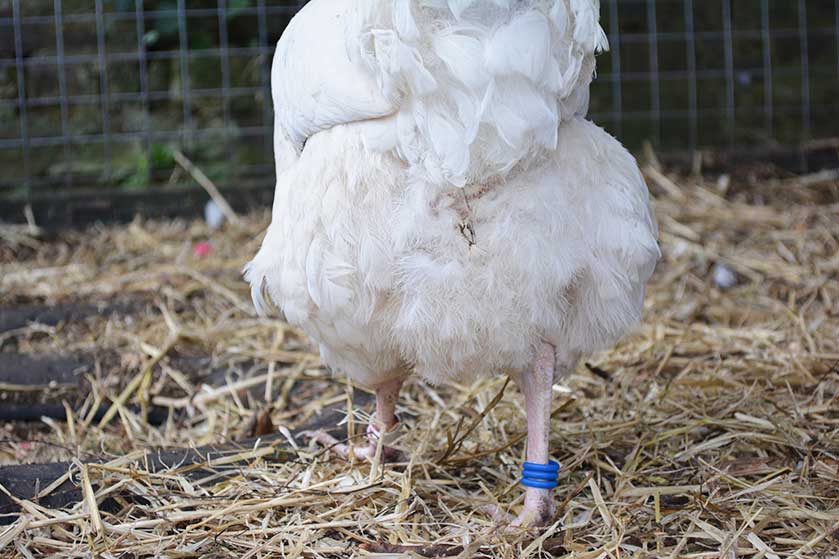
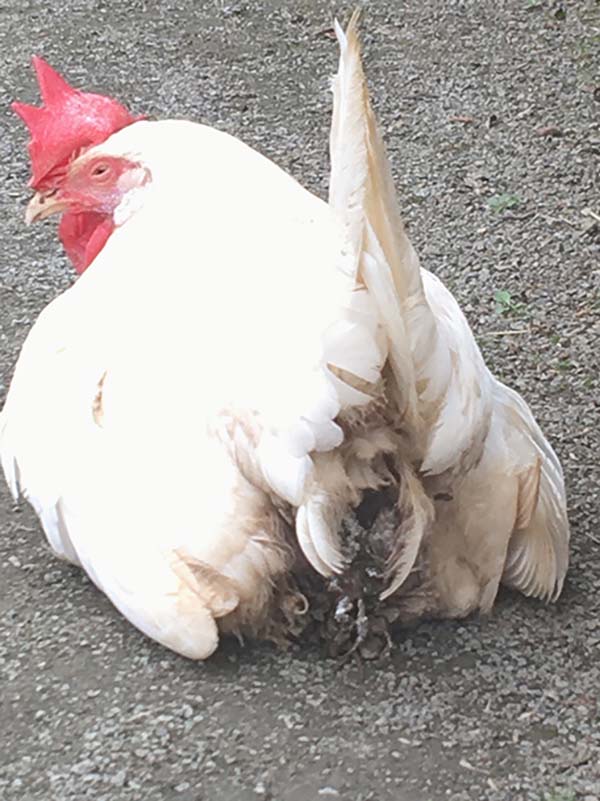
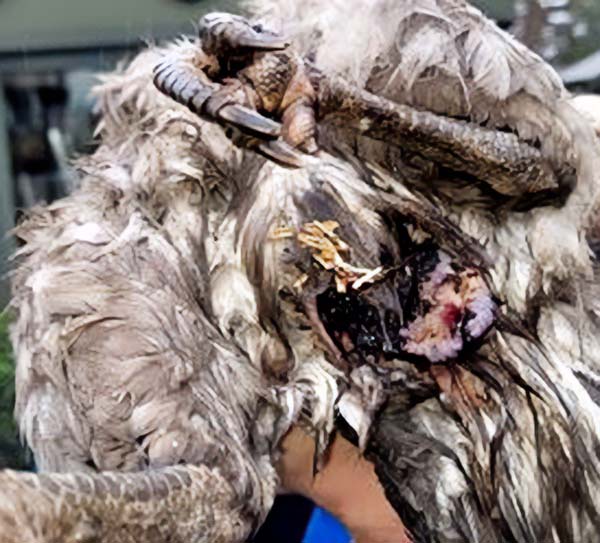
Cloacal palpation is recommended to assess for soft tissue masses or eggs. The skin and feathers should be examined for evidence of parasites, excess scale, inflammation and lesions (Figure 9). Chickens moult once a year, usually around autumn. This can take a few weeks and egg laying is usually reduced in this period. Feather picking at new pin feathers is not uncommon.
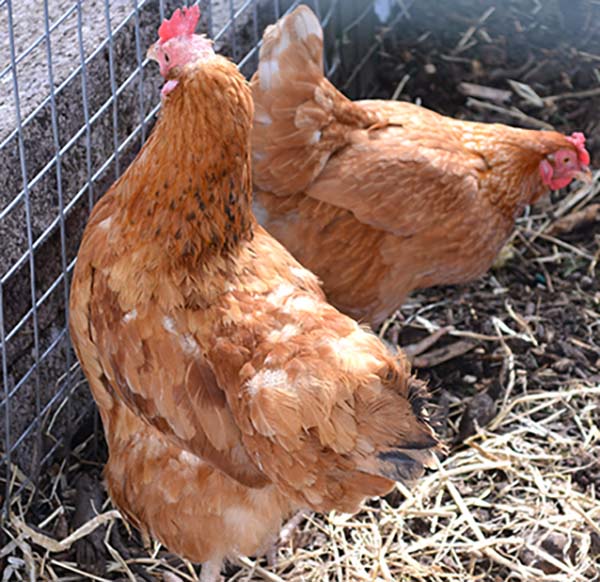
Ex-battery hybrid chicks are usually vaccinated (infectious bronchitis and Marek’s disease), but vaccination of adult birds for most diseases is not that effective. Vaccines can be given if a specific disease problem exists (Roberts, 2014).
All newly acquired birds should ideally be wormed and quarantined for five to six weeks before mixing them with the other chickens. This quarantine period of any new birds will also reduce the risk of spreading infectious respiratory disease. Although the chickens are regarded by their owner as pets, they are legally food-producing animals – regardless of breed, age or the size of the flock – so only medicines with a maximum residue limit (MRL) can be used in the UK. As the regulations differ in different countries, these should be checked before prescribing medicines to poultry.
Regular faecal parasitology should be carried out every three months and treated with a licensed anthelmintic such as flubendazole, based on the faecal parasitology results. Flubendazole 1.43mg/kg once daily, given orally for seven days, is effective against the common species of adult worms, larvae and eggs.
Flubendazole is currently the only licensed wormer for laying hens. As a zero egg withdrawal period exists, the eggs can still be consumed during treatment. Fenbendazole may also be used. A herbal product (Verm-X) is popular with pet chicken owners; however, no efficacy trials exist.
Pet chickens commonly have worms in the gastrointestinal tract, including roundworms (Ascaridia, Capillaria, Heterakis) and multiple tapeworm species. Gape worm in the trachea is not that common in pet chickens. Infection is from wild birds and intermediate insect hosts (earthworms or beetles).
Ascaridia galli causes moderate disease, affecting the small intestine, and causing malabsorption and enteritis. Clinical signs of diarrhoea, pale combs and wattles (anaemia), sharp keel bone, loss of condition and reduced egg production may be seen. The Capillaria species tend to cause more severe disease and different species can cause lesions through most of the digestive tract from the mouth to the ceca.
Heterakis gallinarum usually only causes mild disease, but this nematode can be a carrier of Histomonas meleagridis (blackhead disease), although this may cause less severe illness in chickens than other poultry.
Gapeworm (Syngamus trachea) causes severe disease in the trachea and lungs. The clinical sign include respiratory distress, open mouth breathing, head shaking and neck stretching to dislodge the worms (gaping), coughing and wheezing.
Pyrexia is not a feature of gapeworm, but may be seen in stressed birds and avian influenza. If nasal discharge, sneezing, conjunctivitis, sinusitis or pharyngitis are found on history or examination then avian influenza is a differential diagnosis.
If deaths occur or the birds are very sick then the duty vet at the APHA should be contacted as this is a notifiable disease. Half of the avian infected premises in 2016-17 in the UK involved backyard flocks, not commercial flocks (Clark, 2017).
Other important parasites include the protozoan parasites Eimeria, causing coccidiosis, which multiply in the intestinal tract and cause tissue damage. Clinical signs of diarrhoea, pale combs and wattles, weight loss and loss of condition, and mortality may be seen. Subclinical infections cause enteritis (Yegani and Korver, 2008).
Affected chickens are more susceptible to other infectious diseases. This tends to affect chicks less than 10 days old, but may also be seen in ex-battery hens that have had no prior exposure to low levels of the oocysts to stimulate immunity. Bloody mucoid diarrhoea may be seen and affected birds are often hunched, with ruffled feathers, and pale combs and wattles.
Faecal testing can confirm the diagnosis, although shedding can be intermittent. In mild cases supportive care of oral electrolytes gavage, warmth, clean environment, feeding the correct diet and probiotics may be sufficient. In sick birds amprolium coccidiostat and tylosin to treat secondary bacteria, which are often present, may be indicated.
Poultry red mites (Dermanyssus gallinae) live in the hen house and suck the blood of the chickens overnight, causing anaemia, skin irritation, stress, feather pecking, and a disease vector to the animals and zoonotic diseases.
Regular checking of the hen house at night to spot early infestation is recommended. Thorough cleaning of the hen house should be carried out prior and after treatment.
Treatment with an acaricidal in drinking water, such as fluralaner (licensed for laying chickens), has been shown to be very effective. Diatomaceous earth has also been used, but care needs to be taken to avoid inhalation of the silica particles in this product. Predator mites and beetles are also available to attack the poultry red mite.
Pet chickens are classed as food-producing animals. In the UK medications can only be used in pet chickens if they have a published MRL for any food-producing animal.
The prescribing vet must specify an appropriate withdrawal period, and keep specific records of what was prescribed and the set withdrawal period. It can be difficult to calculate an exact withdrawal period to ensure the drug residues do not exceed the MRL.
The statutory minimum egg withdrawal is 7 days. Zero withdrawal means that the eggs may be eaten when treatment is finished. Egg development takes around 14 to 15 days and some follicles that make up components of the egg are present for several months. Therefore, extending the withdrawal period may be prudent. Please see the references and further reading list at the end of this article for further information on prescribing medications to pet chickens.
Some licensed products for use in laying chickens exist and these must legally be considered before using the cascade. No painkillers or anaesthetics are currently licensed for laying chickens. For welfare reasons it is appropriate to use NSAIDs and other medications (isoflurane) provided they have a published MRL in Table 1 of the Annex to Commission Regulation EU (European Union) No 37/2010. MRLs listed in Commission Regulation (EC) 37/2010 or published in the Official Journal prior to 31 December 2020 will continue to have effect in GB and are included on the list of GB approved MRLs from 1 January 2021 (2021).
| Table 1. Differential diagnosis of abnormal faeces | ||
|---|---|---|
| Appearance of faeces | Suggested differential diagnosis | Further notes |
| Haematochezia | Coccidiosis, viral (adenovirus, rotavirus), severe bacterial infection. | Coccidiosis is common and is seen more in chicks younger than 10 weeks old or ex-battery hens as they have had no prior exposure to coccidian to develop natural immunity. |
| Green urates | Chronic worm burden, liver disease or has eaten a lot of green vegetation. | Green urates are often indicative of liver disease or biliverdinuria. Hetarakis (earthworms) may carry Histomonas, which causes liver disease and yellow green diarrhoea. This is more common in turkeys. A large burden of ascarid worms causes anorexia, enteritis and reduced absorption of the bile pigment biliverdin. |
| White, milky diarrhoea | Worms, coccidiosis, infectious bursal disease (Gumboro disease), salmonellosis. | Infectious bursal disease is caused by a virus causing immunosuppression. |
| Diarrhoea | Bacterial or fungal overgrowth (for example, Escherichia coli, salmonellosis, infection, clostridial overgrowth). | Often malodourous. Dysbiosis due to a dietary indiscretion or co-infection with other pathogens or parasites or poor hygiene of food and water areas are common causes of bacterial diarrhoea. |
| Watery faeces | Stress, infectious bronchitis. | Polyuria is common due to stress but can also be due the same causes as seen in other species including renal disease. |
| Yellow and foamy diarrhoea | Coccidiosis but other pathogens also possible. Salmonellosis. | Caused by Eimeria species and can have high morbidity and mortality rates. |
| Grayish white and running continuously diarrhoea | Vent gleet (a chronic disease of the cloaca of domestic birds). | Malodourous. Cloacal fungal infection caused by Candida albicans. |
The welfare of pet chickens can be greatly improved with support from the veterinary practice. The approach to treating the sick chicken is similar to that of any species and can be very rewarding.
Chickens are flock birds that need to be kept together, so if it is necessary to separate a sick chicken for individual treatment or assessment make sure they are in visual contact with the rest of the flock or travel to the vets with a companion chicken. Keep separation to a minimum to avoid problems with reintroduction.
An awareness of what medications are legal to use in this food animal species is important and will help to give the clinician more confidence in his or her approach to the healthy and sick pet chicken.